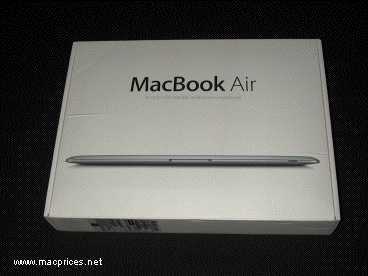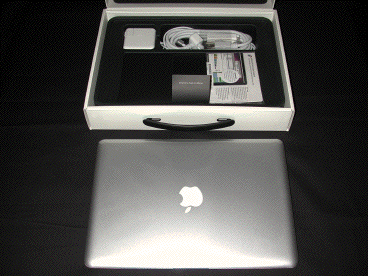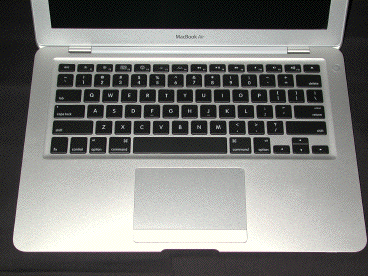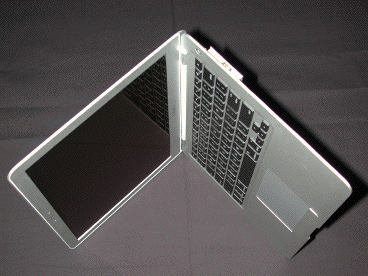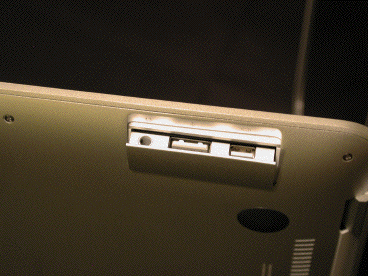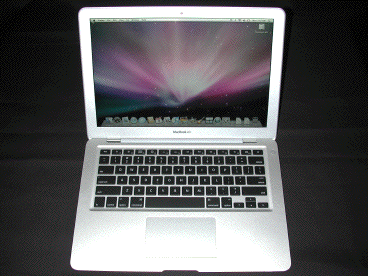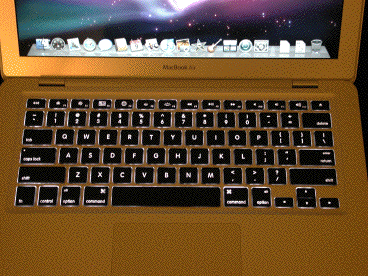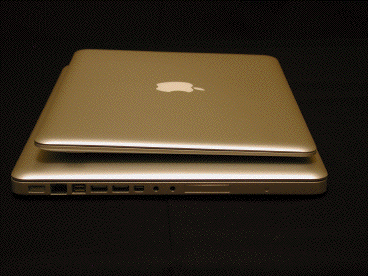Review: 2009 13" MacBook Air
by Charles W. Moore & Steve Hildreth
The 13" MacBook Air is the most 'sub' of all notebooks Apple has ever offered, weighing in as a mere three pounds and only three quarters of an inch thick. It's radically cool-looking and should be a joy to take on the road. However, It remains to be seen whether enough folks will to prevent the MacBook Air from becoming another interesting design exercise that failed in the marketplace like the late, lamented G4 Cube.
The MacBook Air's problem is not with it's undeniably sleek and attractive design, but rather with what went missing in order to pare that weight and thickness down, and there's a lot, plus the fact that it's an essentially non-upgradable semi-sealed unit like an iPod with even battery replacement requiring the case to be opened by professional techs - at least if you don't want to void the warranty.
The MacBook Air comes with a respectable 2GB of RAM soldered to the motherboard, but unfortunately that's also its maximum RAM capacity. There is no RAM expansion slot. The standard hard drive in the base model is a non-standard 1.8" unit of a modest 120GB capacity and 4200 RPM rotation speed, with the only upgrade offered being a 128GB solid-state drive for an extra $300. There are other no provisions for hard drive upgrades.
The base unit starts at $1499, but that includes no (external) optical drive ($99 extra), or if you're on dial-up - modem ($49.00). The upmarket, SSD model is $1799.
For the average computer user, the Air is a perfectly acceptable computer. We tested the SSD model, and for those whose main computer uses consist of email, web surfing, Office use, and digital photo storage, the Air is a fine machine. It's undoubtedly sexy - most people seeing this machine for the first time are smitten by it's thinness. The SSD itself allows for fast start ups and shut downs, as well as quick wake from sleeps. The SSD also allows you to forget about the days of bumping your computer and accidentally crashing the hard drive. Road warriors will love it's small size and, compared to netbooks, real display, keyboard, and trackpad.
Apple includes an Ethernet USB cable in the box for those who prefer to connect to wired networks at home, work, or while on the road.
But back to what you don't get with the MacBook Air. No FireWire - not even an option. Not much else in the way of I/O ports either - just once lonely USB 2.0 port flanked by a headphone jack and a DisplayPort video port. That's all folks, and that USB port has to handle pretty well all peripherals you might need to use - the external SuperDrive, the Ethernet connector, a Microphone if you need one, and external keyboard and mouse, printers and scanners, a modem, and so on. There are no expansion slots of any sort. Apple has an unfortunate history of from time to time building I/O port impoverished notebooks - the PowerBook 150 and the original clamshell iBook come to mind. But even the iBook had a built-in Ethernet port. The MacBook Air's ports are located behind a flip-up door, which is also a bit of a throwback. Built-in sound output is only a mono speaker.
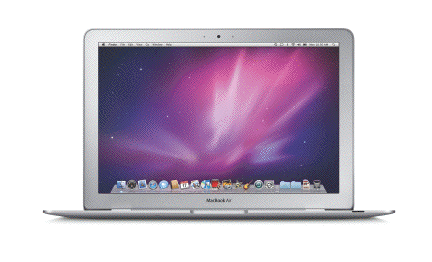
And since the external SuperDrive is a USB and not a FireWire unit, its bootability is an unanswered question mark at this writing. With no FireWire, there is no FireWire Target Disk Mode, although expanded wireless features are intended to take up some of that slack.
As for performance, there's good news and bad news. The MacBook Air is powered by a special, smaller-dimensioned (60% smaller than the standard Intel Core 2 Duo) 1.86GHz or optional ($300.00) 2.13GHz processor with 6MB L2 cache and an 1066MHz frontside bus, which should offer a respectable level of performance, or about even with the 13" 2.13GHz White MacBook. The good news? It should run cooler than its bigger, more powerful stablemates, and unaccompanied by intermittent fan serenades, since there is reportedly no internal cooling fan.
Apple is claiming up to five hours runtime on a battery charge, but if that's not enough for your occasional needs, you're out of luck. The battery is not user-switchable, so you'll have to wait until you fins an AC outlet and through the recharge interval. MacBook Air battery replacement requires sending the machine to Apple, costs $130, and takes 5 business days.
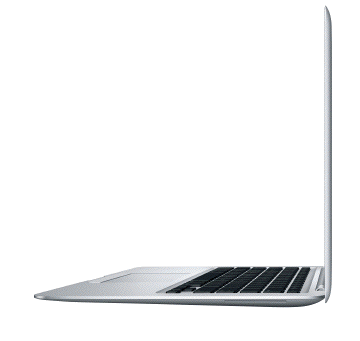
In the aesthetics department, the thinness of the MacBook Air's aluminum case is its most spectacular form factor feature. The keyboard is full-sized and backlit to boot. There is also a a large multitouch trackpad, which supports some of the same kind of functions and gestures iPhone and iPod touch touchpads do, including pinch (moving finger and thumb together or apart) zooming in some applications including Safari and iPhoto, swipe three-finger drag substitute for forward and back commands, and rotate (rotating finger and thumb) which rotates images in iPhoto. The only display available is a 1280x800 13.3" glossy unit a la the standard MacBook Pro. Some folks like glossy screens, other despise them. A similarity shared with the White MacBook is the NVIDIA GeForce 9400M integrated graphics support that annexes 256MB of your 2GB of system RAM.
View a short walk-through video of the MacBook Air:
The MacBook Air is touted as the greenest Apple notebook ever, with its mercury-free LED backlighting, display screen made of arsenic-free glass, most of its internal circuit boards free of brominated flame retardants, and internal cabling that emits PVC vapors. The aluminum case is also recycling-friendly.
The optional external SuperDrive (reminiscent of the external floppy drives that shipped with the great-grandaddy PowerBook 100 and subnotebook predecessor PowerBook 2400c) is USB bus-powered an requires no dedicated power supply.
However, to be fair, if you need a MacBook with an optical drive, FireWire, faster graphics, etc., you should purchase a MacBook Pro or White MacBook.
How does the Air's performance stand up? Quite well, when doing the basic tasks for which it's designed. Higher-end users will want to move up to a MacBook Pro for more speed and beefier graphics. Using Primate Lab's Geekbench 2, the 2.13GHz MacBook Air scored higher than its 1.86GHz predecessor, and quite a bit higher than older G4 'Books. However, it still lags newer MacBook Pros, and even some older MacBook Pros:
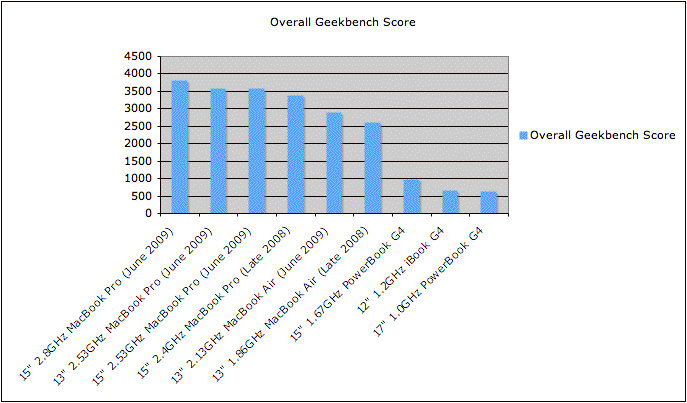
In short, the MacBook Air is currently Apple's answer to the netbook and other subportables. With sufficient power and minimal features, it accomplishes most of what is expected from a basic laptop. It's largely wireless, very portable, stylish, and a willing companion for road warriors. Compared to PC netbooks, you get a small and very thin companion but with a real display, real keyboard, and real trackpad.
